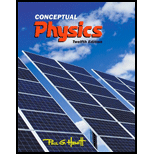
Conceptual Physics (12th Edition)
12th Edition
ISBN: 9780321909107
Author: Paul G. Hewitt
Publisher: PEARSON
expand_more
expand_more
format_list_bulleted
Concept explainers
Textbook Question
Chapter 35, Problem 13RCQ
What do we call the “stretching out” of time?
Expert Solution & Answer
Want to see the full answer?
Check out a sample textbook solution
Students have asked these similar questions
What do we call the “stretching out” of time?
Why the passage of time is different for the observers on Earth and outside the Earth?
Which runs slower, a clock at the top of the tallest skyscraper in Chicago or a clock on the shore of Lake Michigan?
Chapter 35 Solutions
Conceptual Physics (12th Edition)
Ch. 35 - Prob. 1RCQCh. 35 - Prob. 2RCQCh. 35 - Prob. 3RCQCh. 35 - Prob. 4RCQCh. 35 - Prob. 5RCQCh. 35 - Prob. 6RCQCh. 35 - Prob. 7RCQCh. 35 - Prob. 8RCQCh. 35 - Prob. 9RCQCh. 35 - Prob. 10RCQ
Ch. 35 - Prob. 11RCQCh. 35 - Prob. 12RCQCh. 35 - What do we call the “stretching out” of time?Ch. 35 - Prob. 14RCQCh. 35 - Prob. 15RCQCh. 35 - Prob. 16RCQCh. 35 - Prob. 17RCQCh. 35 - Prob. 18RCQCh. 35 - Prob. 19RCQCh. 35 - Prob. 20RCQCh. 35 - Prob. 21RCQCh. 35 - Prob. 22RCQCh. 35 - Prob. 23RCQCh. 35 - Prob. 24RCQCh. 35 - Prob. 25RCQCh. 35 - Prob. 26RCQCh. 35 - Prob. 27RCQCh. 35 - Prob. 28RCQCh. 35 - Prob. 29RCQCh. 35 - Prob. 30RCQCh. 35 - Prob. 31RCQCh. 35 - Prob. 32RCQCh. 35 - Prob. 33RCQCh. 35 - Prob. 34RCQCh. 35 - Prob. 35RCQCh. 35 - Prob. 36RCQCh. 35 - Prob. 37RCQCh. 35 - Prob. 38RCQCh. 35 - Prob. 39RCQCh. 35 - Prob. 40RCQCh. 35 - According to Newtonian mechanics, the momentum of...Ch. 35 - Prob. 42RCQCh. 35 - Prob. 43RCQCh. 35 - Prob. 44RCQCh. 35 - Prob. 45RCQCh. 35 - Prob. 46RCQCh. 35 - Prob. 47RCQCh. 35 - Prob. 48RCQCh. 35 - Prob. 49RCQCh. 35 - Prob. 50RCQCh. 35 - Prob. 51RCQCh. 35 - Prob. 52RCQCh. 35 - Prob. 53RCQCh. 35 - Prob. 54RCQCh. 35 - Prob. 55RCQCh. 35 - Prob. 56RCQCh. 35 - Prob. 57RCQCh. 35 - Prob. 58RCQCh. 35 - Prob. 59RCQCh. 35 - Prob. 60RCQCh. 35 - Prob. 61RCQCh. 35 - Prob. 62RCQCh. 35 - Prob. 63RCQCh. 35 - Prob. 64RCQCh. 35 - Prob. 65RCQCh. 35 - Prob. 66RCQCh. 35 - Prob. 67RCQCh. 35 - Prob. 68RCQCh. 35 - Prob. 69RCQCh. 35 - Prob. 70RCQCh. 35 - Prob. 71RCQCh. 35 - Prob. 72RCQCh. 35 - Prob. 73RCQCh. 35 - Prob. 74RCQCh. 35 - Prob. 75RCQCh. 35 - Prob. 76RCQCh. 35 - Prob. 77RCQCh. 35 - Prob. 78RCQCh. 35 - Prob. 79RCQCh. 35 - Prob. 80RCQCh. 35 - Prob. 81RCQCh. 35 - Prob. 82RCQCh. 35 - Prob. 83RCQCh. 35 - According to E = mc2, how does the amount of...Ch. 35 - Prob. 85RCQCh. 35 - Prob. 86RCQCh. 35 - Prob. 87RCQCh. 35 - Prob. 88RCQCh. 35 - Prob. 89RCQCh. 35 - Prob. 90RCQCh. 35 - Prob. 91RCQCh. 35 - Prob. 92RCQCh. 35 - Prob. 93RCQCh. 35 - Prob. 94RCQCh. 35 - Prob. 95RCQCh. 35 - Prob. 96RCQCh. 35 - Prob. 97RCQCh. 35 - Prob. 98RCQCh. 35 - Prob. 99RCQCh. 35 - Prob. 100RCQ
Knowledge Booster
Learn more about
Need a deep-dive on the concept behind this application? Look no further. Learn more about this topic, physics and related others by exploring similar questions and additional content below.Similar questions
- Please complete full question. The answer is of no use without it.arrow_forwardIn Newtonian mechanics, the speed of lighta) is 3 x 10^8m/s d) will be faster than cb) can be infinite e) none of the abovec) will be slower than carrow_forwardHow is Einstein's treatment of space and time and treating time as one of the dimensions, reflected in the four-vectors formulation of various physical quantities?arrow_forward
- The meter was redefined as a reference to Earth, then to krypton, and finally to the speed of light. Why do you think the reference point for a meter continued to change?arrow_forwardWhen observed from the sun at a particular instant, Earth and Mars appear to move in opposite directions with speeds 108,000 km/h and 86,871 km/h, respectively. What is the speed of Mars at this instant when observed from Earth?arrow_forwardWith regard to reference frames, how does general relativity differ from special relativity?arrow_forward
arrow_back_ios
SEE MORE QUESTIONS
arrow_forward_ios
Recommended textbooks for you

 Stars and GalaxiesPhysicsISBN:9781305120785Author:Michael A. Seeds, Dana BackmanPublisher:Cengage Learning
Stars and GalaxiesPhysicsISBN:9781305120785Author:Michael A. Seeds, Dana BackmanPublisher:Cengage Learning AstronomyPhysicsISBN:9781938168284Author:Andrew Fraknoi; David Morrison; Sidney C. WolffPublisher:OpenStax
AstronomyPhysicsISBN:9781938168284Author:Andrew Fraknoi; David Morrison; Sidney C. WolffPublisher:OpenStax Stars and Galaxies (MindTap Course List)PhysicsISBN:9781337399944Author:Michael A. SeedsPublisher:Cengage Learning
Stars and Galaxies (MindTap Course List)PhysicsISBN:9781337399944Author:Michael A. SeedsPublisher:Cengage Learning Modern PhysicsPhysicsISBN:9781111794378Author:Raymond A. Serway, Clement J. Moses, Curt A. MoyerPublisher:Cengage Learning
Modern PhysicsPhysicsISBN:9781111794378Author:Raymond A. Serway, Clement J. Moses, Curt A. MoyerPublisher:Cengage Learning Principles of Physics: A Calculus-Based TextPhysicsISBN:9781133104261Author:Raymond A. Serway, John W. JewettPublisher:Cengage Learning
Principles of Physics: A Calculus-Based TextPhysicsISBN:9781133104261Author:Raymond A. Serway, John W. JewettPublisher:Cengage Learning


Stars and Galaxies
Physics
ISBN:9781305120785
Author:Michael A. Seeds, Dana Backman
Publisher:Cengage Learning

Astronomy
Physics
ISBN:9781938168284
Author:Andrew Fraknoi; David Morrison; Sidney C. Wolff
Publisher:OpenStax

Stars and Galaxies (MindTap Course List)
Physics
ISBN:9781337399944
Author:Michael A. Seeds
Publisher:Cengage Learning

Modern Physics
Physics
ISBN:9781111794378
Author:Raymond A. Serway, Clement J. Moses, Curt A. Moyer
Publisher:Cengage Learning

Principles of Physics: A Calculus-Based Text
Physics
ISBN:9781133104261
Author:Raymond A. Serway, John W. Jewett
Publisher:Cengage Learning
General Relativity: The Curvature of Spacetime; Author: Professor Dave Explains;https://www.youtube.com/watch?v=R7V3koyL7Mc;License: Standard YouTube License, CC-BY